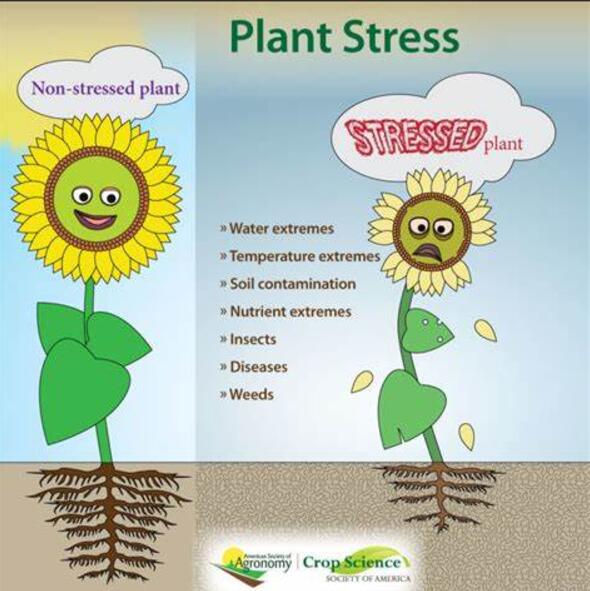水分和养分供应调节油橄榄 Arbequina 栽培品种的盐度胁迫反应
IF 6.8
Q1 PLANT SCIENCES
引用次数: 0
摘要
盐分胁迫是全球农业的一个关键因素。植物可以通过以不同方式调整生理机能来应对盐胁迫,从而限制生长和发育的衰退。重要的是,基质的保湿能力、渗透性和养分可用性是植物的关键变量,因为它们可能会进一步影响渗透胁迫的效果。在此,我们采用多学科方法评估了泥炭和珍珠岩这两种不同基质在不同盐度胁迫条件(0、100 和 200 mM NaCl)下对油橄榄(栽培品种 Arbequina)2 年盆栽插条的作用。生物计量学和生理学数据表明,与泥炭(AS)相比,在盐度胁迫下,珍珠岩(AP)盆栽植物的生长和光合速率普遍较低。离子测量结果表明,随着胁迫严重程度的增加,Na+的积累也在增加,这改变了两种基质中的离子比例。此外,多酚含量也存在差异,AS 和 AP 样本中的喹酸和芦丁含量分别普遍增加。代谢组学和生物计量学数据还与代谢编码分析相结合,表明中度盐度处理(100 mM NaCl,T100)重塑了生长在两种基质上的植物的内生群落。综上所述,这些数据表明,像橄榄树这样的糖生物种应对盐度胁迫的策略似乎与水分和养分的供应有很大关系。珍珠岩可以模拟水分和养分的缺乏,从而增强木本植物盐胁迫反应的效果。最后,应用在此发现的有益内生细菌类群,可以在提高植物防御能力和养分吸收能力方面向前迈出一步,并减少现代农业和更可持续农业的投入。本文章由计算机程序翻译,如有差异,请以英文原文为准。
Water and nutrient availability modulate the salinity stress response in Olea europaea cv. Arbequina
Salinity stress represents a key factor for global agriculture. Plants can respond to salinity stress by adapting their physiology in different ways with the aim of limiting reductions in growth and development. Importantly, moisture retention capacity, permeability and nutrient availability of substrates represent critical variables for plants as they may further influence the effect of osmotic stress. Here, a multidisciplinary approach was applied to evaluate the role of two different substrates, peat and perlite, on 2-year-old potted cuttings of Olea europaea (cultivar Arbequina) under different salinity stress conditions (0, 100 and 200 mM NaCl). Biometric and physiological data indicate that plants potted in perlite (AP) generally present lower growth and photosynthetic rates when compared with peat (AS) in combination with salinity stress. Ion measurements indicate a rise in Na+ accumulation with increasing stress severity, which alters the ion ratio in both substrates. In addition, differences occurred in polyphenol contents, with a general increase in quinic acid and rutin contents in AS and AP samples, respectively. Metabolomic and biometric data were also coupled with metabarcoding analysis, which indicates that the moderate salinity treatment (100 mM NaCl, T100) reshaped the endophytic community of plants grown on both substrates. Taken together, the data suggest that the strategy used by a glycophytic species such as the olive tree to cope with salinity stress seems to be highly related to availability of water and nutrients. The lack of both may be simulated by perlite, enhancing the effect of salinity stress response in woody plants. Lastly, applying the beneficial endophytic bacterial taxa identified here could represent a step forward in increasing plant defence and nutrient uptake and reducing inputs for modern and more sustainable agriculture.
求助全文
通过发布文献求助,成功后即可免费获取论文全文。
去求助
来源期刊

Plant Stress
PLANT SCIENCES-
CiteScore
5.20
自引率
8.00%
发文量
76
审稿时长
63 days
期刊介绍:
The journal Plant Stress deals with plant (or other photoautotrophs, such as algae, cyanobacteria and lichens) responses to abiotic and biotic stress factors that can result in limited growth and productivity. Such responses can be analyzed and described at a physiological, biochemical and molecular level. Experimental approaches/technologies aiming to improve growth and productivity with a potential for downstream validation under stress conditions will also be considered. Both fundamental and applied research manuscripts are welcome, provided that clear mechanistic hypotheses are made and descriptive approaches are avoided. In addition, high-quality review articles will also be considered, provided they follow a critical approach and stimulate thought for future research avenues.
Plant Stress welcomes high-quality manuscripts related (but not limited) to interactions between plants and:
Lack of water (drought) and excess (flooding),
Salinity stress,
Elevated temperature and/or low temperature (chilling and freezing),
Hypoxia and/or anoxia,
Mineral nutrient excess and/or deficiency,
Heavy metals and/or metalloids,
Plant priming (chemical, biological, physiological, nanomaterial, biostimulant) approaches for improved stress protection,
Viral, phytoplasma, bacterial and fungal plant-pathogen interactions.
The journal welcomes basic and applied research articles, as well as review articles and short communications. All submitted manuscripts will be subject to a thorough peer-reviewing process.
 求助内容:
求助内容: 应助结果提醒方式:
应助结果提醒方式:


